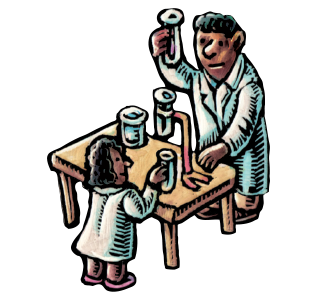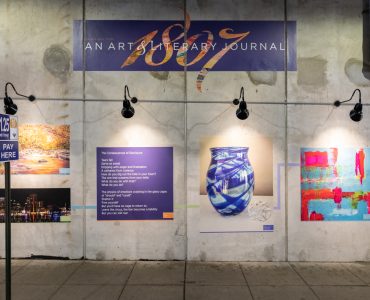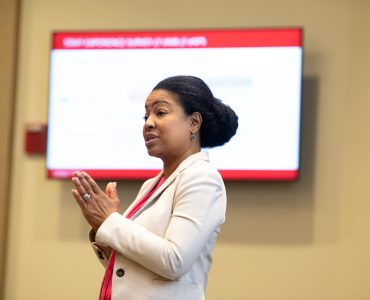n the balcony at the Maryland General Assembly, 13-year-old Lynijah Russell sat alongside several dozen other middle and high school students from West Baltimore. She peered down as the House of Delegates offered a round of applause congratulating Lynijah and her classmates on their accomplishments in the University of Maryland, Baltimore (UMB) CURE Scholars Program.
“I feel like a VIP right now!” exclaimed Lynijah, an eighth-grader at Franklin Square Elementary/Middle School. “I’m just sitting here thinking, ‘Wow, I can’t believe I’m actually here.’”
Lynijah was one of 36 CURE Scholars who traveled to Annapolis on Jan. 28, 2019, for Advocacy Day, which allowed them to present their cancer research posters to prominent Maryland lawmakers.
This unique opportunity was arranged by the UMB CURE Scholars Program, a pilot mentoring program funded by the National Cancer Institute that’s aimed at reducing racial disparities in public health by introducing a pipeline toward careers in STEM (science, technology, engineering, and math) to students in West Baltimore. The program begins in sixth grade and continues through high school, college, and beyond.
“I think the sky’s the limit for Lynijah and all of the scholars because they are so sharp,” says Robin Saunders, EdD, MS, then executive director of the CURE Scholars Program. “Talent is not the problem in West Baltimore, it’s opportunity.”
Talent is not the problem in West Baltimore, it’s opportunity.”
ROBIN SAUNDERS, FOUNDING EXECUTIVE DIRECTOR OF THE UMB CURE SCHOLARS PROGRAM
Lynijah entered the CURE Scholars Program in the fall of 2017. She says the scholars have become her second family and the program is helping her to fulfill her dream of receiving her MD/JD. It’s an ambitious dual degree for a 13-year-old to dream about, but Lynijah is determined to practice both medicine and law.
“There have been times my family needed an awesome doctor or times when we were in need of an awesome lawyer,” she explains. “My mom had cancer and because of the doctor she had, she survived it. My cousin was murdered and because of his lawyer we think that justice wasn’t served in his name. I want to get older and help other people get through what I’ve been through. I want to make sure they don’t feel helpless.”

Lynijah has been diligent in staying on top of her academics to make sure she reaches her goal. At the 2019 CURE End of Year Ceremony, Lynijah received several awards including Academic Excellence for maintaining a GPA between 3.0 and 3.5. She also has taken advantage of several STEM programs outside of CURE including the How Girls Code summer enrichment program at the University of Maryland, Baltimore County and the Saturday Science Academy (SSA) at the National Institutes of Health (NIH). The SSA program is how Lynijah met one of her mentors, Bret Hassel, PhD, an associate professor at the University of Maryland School of Medicine.
“When I first met Lynijah, it was clear from our first interactions that she was an exceptionally talented sixth-grader,” he says. “I got to know her well over the course of the NIH program. It is a pleasure to work with such an enthusiastic student who engenders optimism about Baltimore’s youth and the future of our city.”
Thanks to Hassel and the rest of her mentoring team (the program strives to have a 5:1 mentor-to-scholar ratio), Lynijah has been able to flourish in her academics and in her interests. She jokes that before entering the CURE Scholars Program she watched only the Disney Channel, but now she makes it a point to stay up to date with current events.
“CURE has really changed my life,” she says. “For me, it’s not just an after-school activity, it’s a life program.”
With the opening of UMB’s new Community Engagement Center the CURE Scholars will continue to have more opportunities for success. The new building will be equipped with classrooms, computers, and working science labs to help the scholars continue pursuing their education in STEM.
“It’s going to be a second home for the students and the parents because it will be providing the resources that they need,” Saunders says. “I’m just thrilled that we’ll all be in one place and our families will have access to all kinds of resources.” C




